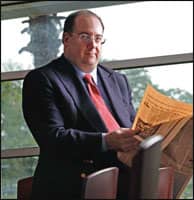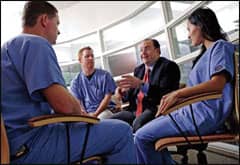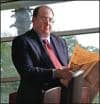by Greg Thompson
Marc Bernard Ackerman, DMD, MBA, is teaching practice management to the next generation of orthodontists
 |
For every practitioner considering new challenges beyond the daily grind of a private practice, Marc Bernard Ackerman, DMD, MBA, is proof that career changes can work. After running a successful office in Bryn Mawr, Pa, for 7 years, Ackerman set his sights down south, eventually winding up as a full-time associate professor at the Jacksonville University (JU) School of Orthodontics in Jacksonville, Fla. He also serves as JU’s director of the Fellowship in Orthodontic Clinical Research
Why did he leave the clinic for the less lucrative academic world? After teaching for at least 1 day per week at the Temple University School of Dentistry Department of Orthodontics during his time as a business owner, Ackerman realized that he truly enjoyed teaching. So he opted to sell the practice and pursue the calling.
Teaching Practice Management
Whether they call him “doctor” or “professor,” students at the JU School of Orthodontics now look to draw from Ackerman’s successful 7-year stint in private practice. As a recent recipient of an MBA degree, Ackerman is also uniquely suited to guide students in the often-neglected arena of practice management.
PRACTICE PROFILE
Orthodontist: Marc Bernard Ackerman, DMD, MBA
Location: Jacksonville University School of Orthodontics, Jacksonville, Fla
Academic position: Associate professor in the School of Orthodontics
Specialty: Surgical orthodontics orthognathic surgery
Years treating patients: 7.5 years in private practice, 3 years at the university facility
Patients per day: 25
Starts per year: Oversees 250
Days worked per week: At school 4 days per week (3 with patient contact and 1 for administrative and research)
Roundtable classes with seminar teaching formats help his charges deal with what is often their greatest challenge: formulating a sound business strategy while they are in school. “Students come out with a tremendous amount of debt—far more than any other generation of graduating orthodontic residents,” Ackerman says. “They must develop a vision, mission, and values that can translate into whatever practice opportunity that they obtain, whether it is starting their own practice, or becoming an associate. They must have an economic plan.”
The desire among newly minted orthodontists for “pay-in-full” contracts may well be the largest error that Ackerman sees. “Novice practitioners accept payment in full because they believe that getting a large war chest will help them get the operation running, and get them out of debt quicker,” Ackerman says. “The problem with having greater than 15% to 20% of a practice taking pay-in-fulls is that if patients move out of town because of job changes or business closures, then ultimately the orthodontist must have a large sum of money somewhere to reimburse those patients. My advice is to limit the number of pay-in-fulls, at least at the start, so that you can slowly grow the business. Do it with recurring monthly payments and contracts spanning the duration of orthodontic treatment.”
Ackerman has developed a core curriculum course called “Special Topics in Practice Management” that students take during the second year of their 2-year residency. The course tackles basic business principles that go into successfully running a private practice, including leadership and strategic planning, marketing, budget and overhead analysis, understanding financial statements, and developing a corporate structure. “We also talk a lot about staff-management issues, compensation and benefits, and customer service,” Ackerman explains. “This course is really going to give them information on topics that they were never exposed to in dental school. Most orthodontic residencies don’t take the time to address these topics.”
Students at Jacksonville University also have the opportunity to earn a 2-year orthodontic certificate combined with an executive MBA in leadership. Another option is a 3-year program covering the 2-year certificate combined with an overlapping 18-month masters degree in education leadership. “The orthodontic certificate and MBA program was developed to prepare someone to understand the business of setting up an orthodontic practice,” Ackerman says. “It could also give the student a sense of what is going on globally within health care, and open the door for individuals interested in branching out into academic administration at a dental school, or perhaps even working in the health insurance industry. As far as the educational leadership program, this flagship program here at JU is really meant to address the shortage of educators in orthodontics.”
Unteaching What They Learned in Dental School
Practitioners like Ackerman, who ultimately decide to transition to the academic world, often find that what they teach is at odds with dental instruction. “The greatest challenge for an orthodontic educator is to have students unlearn some of the things they were taught in dental school,” Ackerman laments. “Orthodontics has been the black-box secret specialty. And as dental students, the little bit of education that they do receive is often painfully outdated. The challenge for an orthodontic educator is to sort of clear the mind of incoming residents, then reteach them how to think like an orthodontist.”
Ackerman tries to tell his students early on that orthodontics should never be a hard sell. Once students understand that they are not mere “occlusionists” or “tooth straighteners,” Ackerman reports that they tend to view the value proposition of orthodontics in the proper light. “The vast majority of patients coming to our office see our service as an enhancement service, and already have some notion of why they are seeking orthodontic treatment,” Ackerman explains. “We have to have the residents divorce themselves from selling the orthodontic case, a term which I quite frankly find vulgar. We are physicians of the oral cavity, and as orthodontists we are change agents for the enhancement of smile and facial appearance.”
 |
| Ackerman teaches his students that they must have an economic plan, but that orthodontics should never be a hard sell. |
Working with Patients
To say Ackerman went from chairside to deskside does not tell the full story, because the University of Rochester-educated orthodontist still works with patients at a freestanding university facility. The low-cost, high-access model used at the site allows Ackerman and his 29 orthodontic residents (plus four research fellows) to charge significantly lower fees than most local practices. As a result, JU clinicians have attracted a large and loyal patient base in the operation’s 6 years of existence.
The inevitable side effect of the low-cost model is that business for orthodontists in the surrounding community has diminished due to the presence of the large university-based clinic. “Jacksonville University is an anomaly in that it was the first orthodontic program to be affiliated with a liberal arts college, in the absence of a traditional dental school, and in the absence of a hospital on-site,” says Ackerman, a co-recipient of the 2004 B.F. and Helen Dewel Award for best clinical paper of the previous year from the American Journal of Orthodontics and Dentofacial Orthopedics. “So it is essentially a freestanding orthodontic residency, with the clinic on a college campus.”
Patients undoubtedly appreciate the low prices, and JU attempts to soften the economic blow for specialties that are not represented on campus. Community-based periodontists, prosthodontists, and oral surgeons work with students on a daily basis, familiarizing residents with proper interdisciplinary protocols.
Orthodontics in the Blood
As a third-generation orthodontist, Ackerman has an appreciation for the art, science, and evolution of the profession. His grandfather A Leon Ackerman, DDS, MPH, was an orthodontist, starting his practice during the early years of the Great Depression in 1932. In the 1940s and 1950s, he was taking x-rays, creating models, and setting the tone for academic orthodontics. “My father [James L. Ackerman, DDS] practiced with my grandfather for approximately 6 years, and then left full-time practice to go into full-time teaching at the University of Pennsylvania,” says Ackerman, who is author of more than two dozen peer-reviewed journal articles as well as the textbook, Enhancement Orthodontics: Theory and Practice from Blackwell Publishing. “My father eventually became chair of the orthodontics department at the University of Pennsylvania in 1968, so there is a rich family history of full-time teaching.”
While Ackerman regularly lauds the private practitioner, he concedes that the life was ultimately just not for him. “Eventually I felt that practicing in a 2,500-square-foot office in a suburb of Philadelphia would not allow me to make a significant contribution to advancing the art and science of orthodontics,” Ackerman says. “Being in an educational setting, you have the immediate effect of influencing the young mind of the resident.” More than 75 years after his grandfather began practicing, much has changed in orthodontics. Ackerman has absorbed the technological revolution and separated the wheat from the chaff for the benefit of his students.
 |
| Ackerman says he gave up his private practice to “have the immediate effect of influencing the young mind of the resident.” |
Adopting “Good Technology”
“My personality is to be an early adopter of technology,” Ackerman says. “I define good technology as something that creates greater efficiency in your practice … you have to prioritize which of those technologies you’re going to adopt, because unless you are independently wealthy, you can’t buy everything.”
Ackerman routinely tells students that the most critical element in today’s practice is an effective orthodontic practice-management software suite—one that integrates all the clinical and administrative functions on one platform. A truly useful system, Ackerman says, should allow anyone in the office—clinical or administrative staff—to be cross-trained for tasks such as generating letters or contracts, viewing images, or entering records.
On the clinical side, Ackerman counts the diode soft-tissue laser as probably the profession’s single most important advancement. “The diode is an adjunct to orthodontic finishing in that the orthodontic practitioner can obtain a more aesthetic result by doing gingival recontouring at the end of treatment,” Ackerman says. “It is an efficiency tool. If there is a posterior tooth that has some extra mucosa, you can trim that away so you can either band or bond that earlier in treatment.”
While he admits that there have been major breakthroughs in treatment, Ackerman still says that from a diagnostic and classification perspective, orthodontics has been relatively the same for the past 100 years. “We are still in the mode of treating the irregularity rather than the etiology,” he contends. “And we are going to be pressed by outside parties to develop outcomes assessments of exactly what we do as orthodontists. We have always thought that it was common sense that there were psychosocial benefits to treatment, but I think that in the future, third-party payors, perhaps even the government, are going to ask us to develop a database that demonstrates our outcomes.”
From Sushi to Sensors
Among several different projects on Ackerman’s research docket is a clinical trial for a device called a smart retainer. While freely admitting his bias (he is chief scientific officer of Atlanta-based Scientific Compliance, which makes the smart retainer), Ackerman says the device has the potential to solve the discrepancy between retainer wear that patients report versus their actual use.
The device features a miniature microsensor embedded in the retainer, which comes with proprietary software and a reader that displays precise retainer use on any PC. The evolution of the device illustrates how ideas can come from anywhere.
The epiphany came from a friend who was puzzled by the freshness of sushi at a land-locked restaurant in the Midwest. “My friend asked the manager, ‘How do you know the sushi is fresh?’ and the guy showed him the special containers that it came in, and there was a special sensor that made sure that container was always at the temperature that it needed to be,” Ackerman says. “They scanned that little sensor, and they can either accept the shipment or decline the shipment, depending on the freshness.”
Ackerman’s friend found out who made the sensors, and reasoning that the mouth has a relatively constant temperature, he and Ackerman honed the sensor, which essentially takes readings every 40 minutes. “I had this idea that orthodontists who want to improve outcomes in clinical practice would jump at the possibility of tracking compliance with any removable appliance,” Ackerman enthuses. “This would give us really important data on our whole philosophy of retention. Who would have thought that the greatest clinical innovation in contemporary orthodontics would come from having sushi in Iowa?”
Greg Thompson is a contributing writer for Orthodontic Products. For more information, contact









